Győr
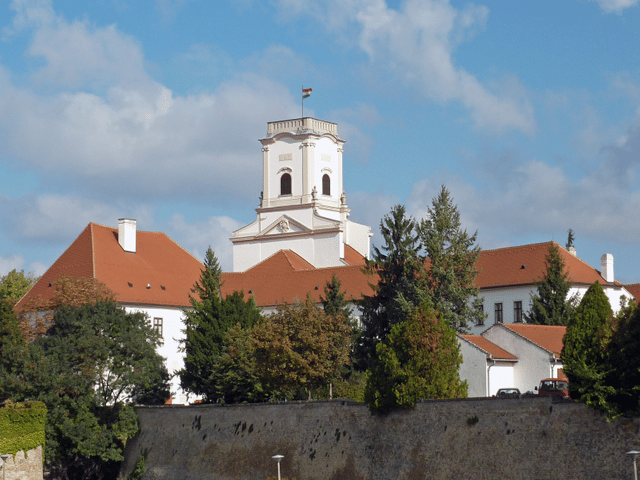
Győr

Győr | |
|---|---|
City with county rights | |
| Győr Megyei Jogú Város | |
      | |
| Coordinates:47°41′03″N 17°38′04″E [25] | |
| Government | |
| • Mayor | Zsolt Borkai (Fidesz) |
| • Deputy Mayor | Dr Tivadar Somogyi (Fidesz-KDNP) Dr Dávid Fekete (Fidesz-KDNP) Ákos Radnóti (Fidesz-KDNP) |
| • Town Notary | Dr Szilárd Lipovits Petra Tibold |
| Area | |
| • City with county rights | 174.62 km2(67.42 sq mi) |
| Elevation | 108 m (354 ft) |
| Population (1 January 2017)[2] | |
| • City with county rights | 129,301[1] |
| • Urban | 246,159 (7th)[3] |
| Population by ethnicity | |
| • Hungarians | 91% |
| • Germans | 6.5% |
| • Romani | 0.8% |
| • Romanians | 0.2% |
| • Croats | 0.2% |
| • Slovaks | 0.2% |
| • Bulgarians | 0.1% |
| • Polish | 0.1% |
| • Others | 0.9% |
| Population by religion | |
| • Roman Catholic | 34.9% |
| • Greek Catholic | 2.3% |
| • Evangelicals | 11.3% |
| • Calvinists | 45.5% |
| • Jews | 2% |
| • Other | 0.0% |
| • Non-religious | 4% |
| Area code(s) | (+36) 96 |
| Motorways | M1, M19, M85 |
| NUTS 3 code | HU221 |
| Distance from Budapest | 121 km (75 mi) East |
| International Airport | Győr (QGY) |
| MP | Róbert Balázs Simon (Fidesz) Ákos Kara (Fidesz) |
| Website | www.gyor.hu [26] |
| Significant minority groups | |
| Nationality | Population (2011) |
| 693 | |
| 187 | |
| 184 | |
| 159 | |
| 70 | |
Győr (US: /djɜːr, dʒɜːr/ DYUR, JUR,[5][6] Hungarian: [ˈɟøːr] (listen); German: Raab; names in other languages) is the most important city of northwest Hungary, the capital of Győr-Moson-Sopron County and Western Transdanubia region, and—halfway between Budapest and Vienna—situated on one of the important roads of Central Europe. The city is the sixth-largest in Hungary, and one of the seven main regional centres of the country.
Győr | |
|---|---|
City with county rights | |
| Győr Megyei Jogú Város | |
      | |
| Coordinates:47°41′03″N 17°38′04″E [25] | |
| Government | |
| • Mayor | Zsolt Borkai (Fidesz) |
| • Deputy Mayor | Dr Tivadar Somogyi (Fidesz-KDNP) Dr Dávid Fekete (Fidesz-KDNP) Ákos Radnóti (Fidesz-KDNP) |
| • Town Notary | Dr Szilárd Lipovits Petra Tibold |
| Area | |
| • City with county rights | 174.62 km2(67.42 sq mi) |
| Elevation | 108 m (354 ft) |
| Population (1 January 2017)[2] | |
| • City with county rights | 129,301[1] |
| • Urban | 246,159 (7th)[3] |
| Population by ethnicity | |
| • Hungarians | 91% |
| • Germans | 6.5% |
| • Romani | 0.8% |
| • Romanians | 0.2% |
| • Croats | 0.2% |
| • Slovaks | 0.2% |
| • Bulgarians | 0.1% |
| • Polish | 0.1% |
| • Others | 0.9% |
| Population by religion | |
| • Roman Catholic | 34.9% |
| • Greek Catholic | 2.3% |
| • Evangelicals | 11.3% |
| • Calvinists | 45.5% |
| • Jews | 2% |
| • Other | 0.0% |
| • Non-religious | 4% |
| Area code(s) | (+36) 96 |
| Motorways | M1, M19, M85 |
| NUTS 3 code | HU221 |
| Distance from Budapest | 121 km (75 mi) East |
| International Airport | Győr (QGY) |
| MP | Róbert Balázs Simon (Fidesz) Ákos Kara (Fidesz) |
| Website | www.gyor.hu [26] |
| Significant minority groups | |
| Nationality | Population (2011) |
| 693 | |
| 187 | |
| 184 | |
| 159 | |
| 70 | |
History
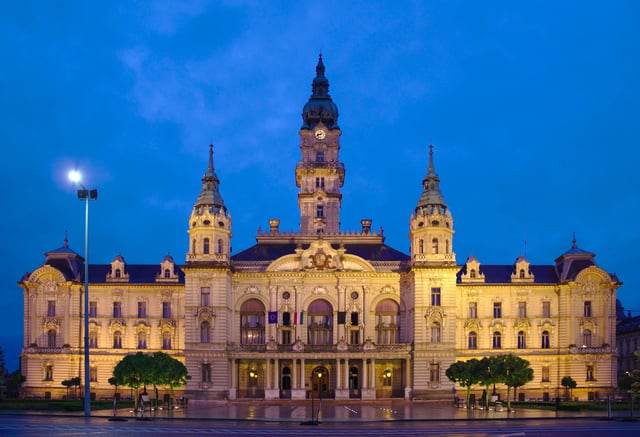
Town Hall
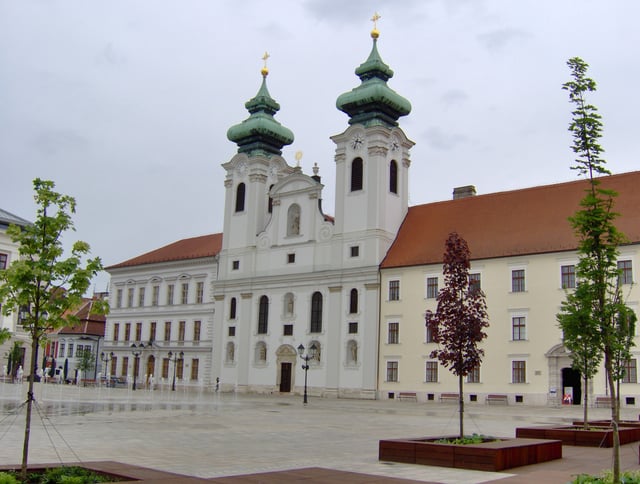
Széchenyi Square
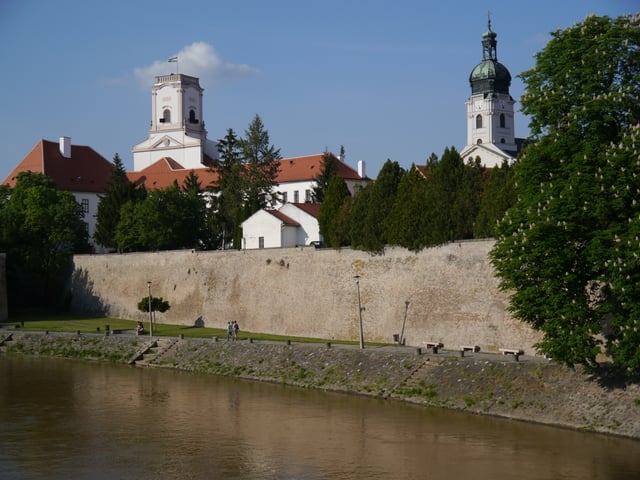
Rába at Győr
The area along the Danube River has been inhabited by varying cultures since ancient times. The first large settlement dates back to the 5th century BCE; the inhabitants were Celts. They called the town Ara Bona "Good altar", later contracted to Arrabona, a name which was used until the eighth century. Its shortened form is still used as the German (Raab) and Slovak (Ráb) names of the city.
Roman merchants moved to Arrabona during the 1st century BCE. Around 10 CE, the Roman army occupied the northern part of Western Hungary, which they called Pannonia. Although the Roman Empire abandoned the area in the 4th century due to constant attacks by the tribes living to the east, the town remained inhabited.
Around 500 the territory was settled by Slavs, in 547 by the Lombards, and in 568–c. 800 by the Avars, at that time under Frankish and Slavic influence. During this time it was called Rabba and later Raab. Between 880 and 894, it was part of Great Moravia, and then briefly under East Frankish dominance.
The Magyars occupied the town around 900 and fortified the abandoned Roman fortress. Stephen I, the first king of Hungary, founded an episcopate there. The town received its Hungarian name Győr. The Hungarians lived in tents, later in cottages, in what is now the southeastern part of the city centre. The town was affected by all the trials and tribulations of the history of Hungary: it was occupied by Mongols during the Mongol invasion of Hungary (1241–1242) and then was destroyed by the Czech army in 1271.
After the disastrous battle of Mohács, Baron Tamás Nádasdy and Count György Cseszneky occupied the town for King Ferdinand I while John Zápolya also was attempting to annex it. During the Ottoman occupation of present-day central and eastern Hungary[7] (1541 - late 17th century), Győr's commander Kristóf Lamberg thought it would be futile to try to defend the town from the Turkish army. He burned down the town and the Turkish forces found nothing but blackened ruins, hence the Turkish name for Győr, Yanık kale ("burnt castle").
During rebuilding, the town was surrounded with a castle and a city wall designed by the leading Italian builders of the era. The town changed in character during these years, with many new buildings built in Renaissance style, but the main square and the grid of streets remained.
In 1594, after the death of Count János Cseszneky, captain of Hungarian footsoldiers, the Ottoman army occupied the castle and the town. In 1598 the Hungarian and Austrian army took control of it again and occupied it.[8] During the Turkish occupation the city was called Yanık Kala (burned place, as a reference to the enormous damages caused by the siege).[9]
In 1683, the Turks returned briefly, only to leave after being defeated in the Battle of Vienna.
During the following centuries, the town became prosperous. In 1743 Győr was elevated to free royal town status by Maria Theresa. The religious orders of Jesuits and Carmelites settled there, building schools, churches, a hospital, and a monastery.
In June 14, 1809, during the War of the Fifth Coalition this was the site of the Battle of Győr (Battle of Raab), where the army of Eugène de Beauharnais defeated the Hungarian "noble insurrection" (militia) and an Austrian corps under the Archdukes Joseph and Johann. Napoleon's forces occupied the castle and had some of its walls blown up. The leaders of the town soon realized that the old ramparts were not useful any more. Most of the ramparts were destroyed, allowing the town to expand.
In the mid-19th century, Győr's role in trade grew as steamship traffic on the River Danube began. The town lost its importance in trade when the railway line between Budapest and Kanizsa superseded river traffic after 1861. The town leaders compensated for this loss with industrialisation. The town prospered until World War II when several buildings were destroyed. Some large-scale terror-bombings devastated industrial and residential areas as well as the airport. It was targeted because the Rába factory was a main tank (Turán) and aeroplane (Bf 109) producer. One of these raids destroyed some parts of the maternity hospital.[10]
| Historical population | ||
|---|---|---|
| Year | Pop. | ±% |
| 1870 | 21,767 | — |
| 1890 | 28,175 | +29.4% |
| 1900 | 38,094 | +35.2% |
| 1910 | 45,083 | +18.3% |
| 1920 | 51,268 | +13.7% |
| 1930 | 52,456 | +2.3% |
| 1941 | 58,431 | +11.4% |
| 1949 | 58,431 | +0.0% |
| 1960 | 72,060 | +23.3% |
| 1970 | 102,600 | +42.4% |
| 1980 | 124,147 | +21.0% |
| 1990 | 129,331 | +4.2% |
| 2001 | 129,412 | +0.1% |
| 2011 | 129,527 | +0.1% |
| 2019 | 132,038 | +1.9% |
The 1950s and '60s brought more change: only big blocks of flats were built, and the old historical buildings were not given care or attention. In the 1970s the reconstruction of the city centre began; old buildings were restored and reconstructed. In 1989 Győr won the European award for the protection of monuments.
A 100-year-old Raba factory on the River Danube close to the historical centre is to be replaced by a new community called Városrét. The mixed-use community will have residential and commercial space as well as schools, clinics and parks.
The city's main theatre is the National Theatre of Győr, finished in 1978. It features large ceramic ornaments made by Victor Vasarely.
The city has several historical buildings, for example the castle, and the Lutheran Evangelic church.
Climate
| Climate data for Győr (1971–2000) | |||||||||||||
|---|---|---|---|---|---|---|---|---|---|---|---|---|---|
| Month | Jan | Feb | Mar | Apr | May | Jun | Jul | Aug | Sep | Oct | Nov | Dec | Year |
| Average high °C (°F) | 2.6 (36.7) | 5.3 (41.5) | 10.7 (51.3) | 16.0 (60.8) | 21.5 (70.7) | 24.3 (75.7) | 26.6 (79.9) | 26.3 (79.3) | 21.5 (70.7) | 15.6 (60.1) | 8.0 (46.4) | 3.9 (39.0) | 15.2 (59.4) |
| Daily mean °C (°F) | −0.5 (31.1) | 1.3 (34.3) | 5.5 (41.9) | 10.4 (50.7) | 15.7 (60.3) | 18.6 (65.5) | 20.4 (68.7) | 19.9 (67.8) | 15.5 (59.9) | 10.2 (50.4) | 4.6 (40.3) | 1.1 (34.0) | 10.2 (50.4) |
| Average low °C (°F) | −3.3 (26.1) | −1.9 (28.6) | 1.6 (34.9) | 5.4 (41.7) | 10.1 (50.2) | 13.1 (55.6) | 14.7 (58.5) | 14.4 (57.9) | 10.8 (51.4) | 6.0 (42.8) | 1.6 (34.9) | −1.4 (29.5) | 5.9 (42.6) |
| Average precipitation mm (inches) | 32 (1.3) | 33 (1.3) | 28 (1.1) | 38 (1.5) | 55 (2.2) | 64 (2.5) | 53 (2.1) | 65 (2.6) | 38 (1.5) | 35 (1.4) | 53 (2.1) | 38 (1.5) | 532 (21.1) |
| Average precipitation days(≥ 1.0 mm) | 7 | 6 | 7 | 7 | 8 | 9 | 7 | 7 | 6 | 5 | 8 | 7 | 84 |
| Mean monthly sunshine hours | 60 | 97 | 138 | 189 | 247 | 250 | 268 | 259 | 188 | 143 | 73 | 51 | 1,963 |
| Source #1: Meteorological Service of Hungary[11] | |||||||||||||
| Source #2: HKO [27] (precipitation, 1961–1990) | |||||||||||||
Main sights
The ancient core of the city is Káptalan Hill at the confluence of three rivers: the Danube, Rába, and Rábca. Püspökvár, the residence of Győr’s bishops, can be easily recognized by its incomplete tower. Győr’s oldest buildings are the 13th-century dwelling tower and the 15th-century Gothic Dóczy Chapel. The Cathedral, originally in Romanesque style, was rebuilt in Gothic and Baroque style.
Other sights include:
Town Hall
Benedictine church of St. Ignatius of Loyola
Carmelite church
Museum of Roman Archaeology
The Pannonhalma Archabbey is located some 20 km (12 miles) outside the town.
Renovation

The new Dunakapu Tér
After the year 2000 the city started many big construction and renovation projects.
The bigger changes include:
The Nádor-underpass, which relieved the Downtown's traffic infrastructure, and made the renovation of the Baross-Bridge possible.
Renovation of the Baross-Bridge.
Renovation of the old Soviet barracks and Bus Station by the company Leier.
Development of the Széchenyi István University, which is in close connection with AUDI Hungária ZRT.
Newly built Parking Houses which take off the high traffic load of the Downtown area. (e.g. József Attila and Dunakapu garage)
Renovation of the inner-downtown district. Széchenyi-square, Dunakapu-square, the territory next to the Moson-Danube and Rába.
Free City Bus which can used by everyone to get anywhere in the Downtown Area.
The Győr Arcade at Városliget.
The Kálóczy Square near the Széchenyi István University.
The Jedlik Bridge, which enabled traffic & transport between Sziget and Révfalu district.
The Rába Quelle thermal spa
Economy
Audi AG subsidiary company Audi Hungaria Motor Kft. has a large factory in Győr, where the Audi TT sports car, the A3 Cabriolet,[12] A3 Limousine,[13] and many engines (1,913,053 engines in 2007) are built. The factory opened in 1994, at first producing inline-four engines for the Audi marque. Business then grew to assembling the Audi TT Coupé and TT Roadster. Eventually, V6 and V8 engines were also included, and after the acquisition of Automobili Lamborghini S.p.A., Audi then began to build V10 engines. The V10s for Audi vehicles are fully assembled here, but only the cylinder blocks for the Lamborghini V10.[14] Engines are also supplied to other Volkswagen Group marques, but over 90% of Audi vehicle engines are made here.[15]
Notable people
Johann Georg Albrechtsberger, composer
Tamás Bakócz, archbishop
Miklós Borsos, sculptor
György Cseszneky, count, castellan
János Cseszneky, count, infantry commander
Josef Dobrovský
Erzsébet Galgóczi, writer
Anita Görbicz, handball player
Izidor Guzmics
Stanley Jaki
Ányos Jedlik
Andrew Karpati Kennedy, author and literary critic
Gyula Kőnig
Margit Kovács
Raimondo Montecuccoli
Árpád Orbán (1938–2008), footballer
Desiderius Orban, painter, one of The Eight, who emigrated in 1939 to Australia
Antal Pusztai
Alexander Raab, pianist
Hans Richter, conductor
Frigyes Riesz, mathematician
Marcel Riesz, mathematician
Samuel Aba, king of Hungary
Ľudovít Štúr
József Szlávy, prime minister of Hungary
Miklós Takács de Saár, silviculturalist, politician
Tibor Varga
Garcilaso de la Vega, poet
Paul von Werner, Prussian Lieutenant General
Emil Zuckerkandl
Freddie
Transport
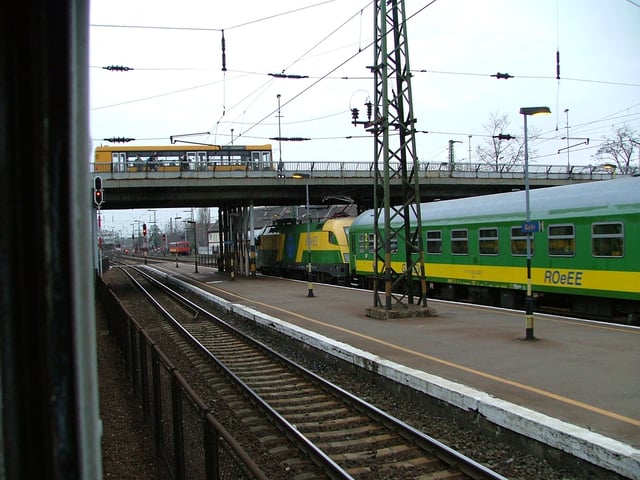
Győr train station under the Baross Bridge in 2008
The city is a national hub for rail and road traffic. The transport-geographical position of Győr is excellent. The most important railway connections are the Vienna-Budapest railway line, but the Győr-Sopron railway line owned by the Győr-Sopron-Ebenfurt railway company, as well as the Győr-Celldömölk railway line and the Győr-Veszprém railway run by MÁV. In Győr, several main transport routes meet each other (M1, M19, 1, 14, 81, 82, 83, 85), and the motorway is accessible from several parts of the city. Győr-Pér Airport can be reached from the city on Highway 81, 15 kilometers towards Székesfehérvár. At the 1734 km section of the Danube lies the port of Győr-Gönyű with its fully equipped 25 hectare serving terminal.
Sports
Győr is the home of the Győri ETO Sport Club, which has many sport divisions. The most popular sport in the city is handball, with the Győri ETO KC being the city's main team. Győri ETO FC is a football team.
Twin towns — sister cities
[[INLINE_IMAGE|//upload.wikimedia.org/wikipedia/commons/thumb/b/bc/Flag_of_Finland.svg/23px-Flag_of_Finland.svg.png|//upload.wikimedia.org/wikipedia/commons/thumb/b/bc/Flag_of_Finland.svg/35px-Flag_of_Finland.svg.png 1.5x, //upload.wikimedia.org/wikipedia/commons/thumb/b/bc/Flag_of_Finland.svg/46px-Flag_of_Finland.svg.png 2x|Finland|h14|w23|thumbborder flagicon-img flagicon-img]] Kuopio, Finland
[[INLINE_IMAGE|//upload.wikimedia.org/wikipedia/en/thumb/b/ba/Flag_of_Germany.svg/23px-Flag_of_Germany.svg.png|//upload.wikimedia.org/wikipedia/en/thumb/b/ba/Flag_of_Germany.svg/35px-Flag_of_Germany.svg.png 1.5x, //upload.wikimedia.org/wikipedia/en/thumb/b/ba/Flag_of_Germany.svg/46px-Flag_of_Germany.svg.png 2x|Germany|h14|w23|thumbborder flagicon-img flagicon-img]] Erfurt, Germany
[[INLINE_IMAGE|//upload.wikimedia.org/wikipedia/en/thumb/b/ba/Flag_of_Germany.svg/23px-Flag_of_Germany.svg.png|//upload.wikimedia.org/wikipedia/en/thumb/b/ba/Flag_of_Germany.svg/35px-Flag_of_Germany.svg.png 1.5x, //upload.wikimedia.org/wikipedia/en/thumb/b/ba/Flag_of_Germany.svg/46px-Flag_of_Germany.svg.png 2x|Germany|h14|w23|thumbborder flagicon-img flagicon-img]] Sindelfingen, Germany
[[INLINE_IMAGE|//upload.wikimedia.org/wikipedia/en/thumb/b/ba/Flag_of_Germany.svg/23px-Flag_of_Germany.svg.png|//upload.wikimedia.org/wikipedia/en/thumb/b/ba/Flag_of_Germany.svg/35px-Flag_of_Germany.svg.png 1.5x, //upload.wikimedia.org/wikipedia/en/thumb/b/ba/Flag_of_Germany.svg/46px-Flag_of_Germany.svg.png 2x|Germany|h14|w23|thumbborder flagicon-img flagicon-img]] Ingolstadt, Germany
[[INLINE_IMAGE|//upload.wikimedia.org/wikipedia/en/thumb/c/c3/Flag_of_France.svg/23px-Flag_of_France.svg.png|//upload.wikimedia.org/wikipedia/en/thumb/c/c3/Flag_of_France.svg/35px-Flag_of_France.svg.png 1.5x, //upload.wikimedia.org/wikipedia/en/thumb/c/c3/Flag_of_France.svg/45px-Flag_of_France.svg.png 2x|France|h15|w23|thumbborder flagicon-img flagicon-img]] Colmar, France
[[INLINE_IMAGE|//upload.wikimedia.org/wikipedia/en/thumb/f/f3/Flag_of_Russia.svg/23px-Flag_of_Russia.svg.png|//upload.wikimedia.org/wikipedia/en/thumb/f/f3/Flag_of_Russia.svg/35px-Flag_of_Russia.svg.png 1.5x, //upload.wikimedia.org/wikipedia/en/thumb/f/f3/Flag_of_Russia.svg/45px-Flag_of_Russia.svg.png 2x|Russia|h15|w23|thumbborder flagicon-img flagicon-img]] Bryansk, Russia
[[INLINE_IMAGE|//upload.wikimedia.org/wikipedia/commons/thumb/7/73/Flag_of_Romania.svg/23px-Flag_of_Romania.svg.png|//upload.wikimedia.org/wikipedia/commons/thumb/7/73/Flag_of_Romania.svg/35px-Flag_of_Romania.svg.png 1.5x, //upload.wikimedia.org/wikipedia/commons/thumb/7/73/Flag_of_Romania.svg/45px-Flag_of_Romania.svg.png 2x|Romania|h15|w23|thumbborder flagicon-img flagicon-img]] Brașov, Romania
[[INLINE_IMAGE|//upload.wikimedia.org/wikipedia/commons/thumb/d/d4/Flag_of_Israel.svg/21px-Flag_of_Israel.svg.png|//upload.wikimedia.org/wikipedia/commons/thumb/d/d4/Flag_of_Israel.svg/32px-Flag_of_Israel.svg.png 1.5x, //upload.wikimedia.org/wikipedia/commons/thumb/d/d4/Flag_of_Israel.svg/41px-Flag_of_Israel.svg.png 2x|Israel|h15|w21|thumbborder flagicon-img flagicon-img]] Nof Hagalil, Israel
[[INLINE_IMAGE|//upload.wikimedia.org/wikipedia/commons/thumb/f/fa/Flag_of_the_People%27s_Republic_of_China.svg/23px-Flag_of_the_People%27s_Republic_of_China.svg.png|//upload.wikimedia.org/wikipedia/commons/thumb/f/fa/Flag_of_the_People%27s_Republic_of_China.svg/35px-Flag_of_the_People%27s_Republic_of_China.svg.png 1.5x, //upload.wikimedia.org/wikipedia/commons/thumb/f/fa/Flag_of_the_People%27s_Republic_of_China.svg/45px-Flag_of_the_People%27s_Republic_of_China.svg.png 2x|China|h15|w23|thumbborder flagicon-img flagicon-img]] Wuhan, China
[[INLINE_IMAGE|//upload.wikimedia.org/wikipedia/en/thumb/1/12/Flag_of_Poland.svg/23px-Flag_of_Poland.svg.png|//upload.wikimedia.org/wikipedia/en/thumb/1/12/Flag_of_Poland.svg/35px-Flag_of_Poland.svg.png 1.5x, //upload.wikimedia.org/wikipedia/en/thumb/1/12/Flag_of_Poland.svg/46px-Flag_of_Poland.svg.png 2x|Poland|h14|w23|thumbborder flagicon-img flagicon-img]] Poznań, Poland[18]
[[INLINE_IMAGE|//upload.wikimedia.org/wikipedia/commons/thumb/f/fe/Flag_of_Uruguay.svg/23px-Flag_of_Uruguay.svg.png|//upload.wikimedia.org/wikipedia/commons/thumb/f/fe/Flag_of_Uruguay.svg/35px-Flag_of_Uruguay.svg.png 1.5x, //upload.wikimedia.org/wikipedia/commons/thumb/f/fe/Flag_of_Uruguay.svg/45px-Flag_of_Uruguay.svg.png 2x|Uruguay|h15|w23|thumbborder flagicon-img flagicon-img]] Montevideo, Uruguay



